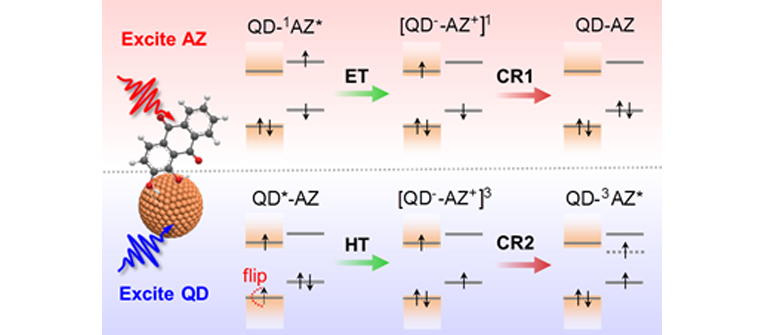A research group led by Prof. WU Kaifeng from the Dalian Institute of Chemical Physics (DICP) of the Chinese Academy of Sciences reported their latest progress on the mechanisms of charge recombination across the inorganic/organic interface. By building model systems with inorganic semiconductor quantum dots (QDs) and surface-anchored organic molecules, and using femtosecond laser spectroscopy, they revealed a novel mechanism of spin-controlled charge recombination pathways and dynamics across the inorganic/organic interface. The results were recently published in J. Am. Chem. Soc.

Spin-controlled charge recombination pathways across the inorganic quantum dot/organic molecules interface. (Image by WANG Junhui)
QD-molecule hybrid materials can find important applications in photocatalysis, light-emitting devices and photon managements. They are also excellent model systems for fundamental studies of charge and/or energy transfer across the inorganic/organic interface, which have already been extensively investigated in the literature.
Principles of controlling charge transfer and recombination via energetics and electronic coupling have been established. However, the use of electron spin to control transfer and recombination pathways in such systems remains relatively underexplored. In contrast, the concept of spin-correlated radical pairs (SC-RPs) has been extensively studied for all-organic donor-acceptor or donor-bridge-acceptor structures, largely motivated by reports of such SC-RPs in photosynthetic systems in nature.
The WU group designed CdS QD-alizarin (AZ) molecule hybrid materials with staggered band alignments such that charge separation can be induced by selective excitation of either QDs or AZ using ultrafast lasers.
They found that exciting AZs led to QD--AZ+ charge separated states which subsequently recombined to regenerate ground state QD-AZ complexes as the major products. Exciting QDs led to presumably the same QD--AZ+ charge separated states, the recombination of which, however, did not return to the ground states. Rather, they observed super long-lived photoproducts from the recombination. These photoproducts were identified as the spin triplet states of the AZ molecules (3AZ*).
Detailed mechanistic analysis suggests that it is the difference between the electron and hole spin flip rates that determines the different charge recombination pathways. The electrons injected from photoexcited AZ to the conduction band of QDs have slow spin flip rates because of a weak spin-orbital coupling in the conduction band; as a result, the charge separated states maintain a spin-singlet feature ([QD--AZ+]1) during charge recombination and hence returned to the ground states which are spin singlets.
In contrast, when QDs are selectively excited, because of very fast (sub-picosecond) spin flip of the photogenerated holes in the valence band of QDs, the charge separated states are dominated by spin triplets ([QD--AZ+]3). Their recombination thus produces AZ triplet states because of spin conservation.
The excitation dependence of charge recombination pathways is a unique feature of these QD-molecule hybrid materials enabled by the different spin configurations between photoexcited QDs (with an ill-defined spin) and AZ (spin singlet) and by the asymmetric electron and hole spin flip rates in II-VI group QDs. Using electron spin to control charge transfer and recombination has important implications for the implementation of these materials in light-driven energy transduction.
This work was supported by the Ministry of Science and Technology of China, the Chinese Academy of Sciences, the National Natural Science Foundation of China and the LiaoNing Revitalization Talents Program. (Text by WANG Junhui)